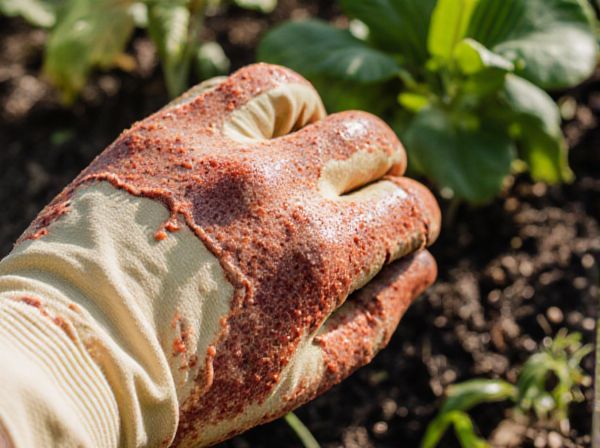
Anthracnose vs Powdery Mildew Illustration
Anthracnose causes dark, sunken lesions primarily on leaves and stems, leading to leaf drop and fruit rot, while powdery mildew appears as a white, powdery coating on leaf surfaces that distorts growth and reduces photosynthesis. Anthracnose thrives in wet, humid conditions, whereas powdery mildew favors dry, warm environments with high humidity at night. Effective management includes removing infected plant parts and applying targeted fungicides to prevent spread and protect plant health.
Table of Comparison
| Feature | Anthracnose | Powdery Mildew |
|---|---|---|
| Pathogen Type | Fungal (Colletotrichum spp.) | Fungal (Erysiphaceae family) |
| Symptoms | Dark, sunken lesions on leaves, stems, and fruits | White, powdery fungal growth on leaf surfaces |
| Host Plants | Beans, cucumbers, tomatoes, mangoes | Grapes, cucumbers, melons, roses |
| Conditions Favoring Infection | Warm, wet, humid environments with leaf wetness | Warm, dry nights with high humidity during day |
| Spread Mechanism | Rain splash, infected plant debris, tools | Airborne spores |
| Control Methods | Fungicides, crop rotation, removing infected debris | Fungicides, resistant varieties, improving air circulation |
| Impact on Plant Health | Can cause defoliation and fruit rot, reducing yield | Reduces photosynthesis, weakens plants, lowers fruit quality |
Defining Anthracnose and Powdery Mildew
Anthracnose is a fungal disease characterized by dark, sunken lesions on leaves, stems, and fruits, primarily caused by fungal genera such as Colletotrichum and Gloeosporium. Powdery mildew appears as white to grayish powdery spots on the surface of leaves, stems, and flowers, caused by fungi from the order Erysiphales. Both diseases result in reduced plant vigor and yield but differ in symptoms, fungal pathogens, and environmental preferences.
Common Host Plants Affected
Anthracnose commonly affects host plants such as maple, sycamore, dogwood, and beans, causing dark, sunken lesions on leaves and stems that lead to defoliation and reduced crop yield. Powdery mildew primarily targets a wide range of hosts including cucumbers, squash, grapes, and roses, characterized by white, powdery fungal growth on leaf surfaces that inhibits photosynthesis and weakens plant vigor. Both diseases significantly impact ornamental and agricultural plants, but their specific host preferences and visual symptoms help in accurate diagnosis and effective management.
Key Symptoms and Visual Differences
Anthracnose symptoms include dark, sunken lesions on leaves, stems, and fruit, often causing leaf curling and defoliation, while powdery mildew appears as white to gray powdery fungal growth on leaf surfaces and stems, leading to distortion and yellowing. Anthracnose lesions tend to be irregularly shaped with a wet or oily appearance, contrasting with the dry, powdery texture of powdery mildew. These visual differences help in accurate diagnosis and targeted treatment strategies.
Disease Life Cycles Compared
Anthracnose fungi survive in plant debris and overwinter as spores or mycelium, spreading through rain splash or wind during wet conditions, with infection cycles accelerating in warm, humid environments. Powdery mildew fungi overwinter as resting spores on plant surfaces or in soil, releasing spores that disperse by wind and infect host tissues primarily in dry, moderate humidity conditions. The contrasting life cycles involve anthracnose requiring moisture for spore germination while powdery mildew thrives in drier ambient humidity, influencing timing and methods for disease control.
Environmental Conditions Favoring Each Disease
Anthracnose thrives in warm, wet environments with high humidity and frequent rainfall, often affecting plants during spring and early summer. Powdery mildew prefers dry, warm conditions with high humidity but minimal free water on leaf surfaces, commonly developing in late summer or early fall. Understanding these specific environmental conditions helps in predicting and managing outbreaks of each fungal disease effectively.
Prevention and Cultural Control Methods
Anthracnose and powdery mildew can be effectively managed through cultural control by maintaining proper plant spacing to improve air circulation and reduce humidity. Removing and destroying infected plant debris prevents the spread of fungal spores, while avoiding overhead irrigation minimizes leaf wetness that favors fungal development. Implementing crop rotation with non-host plants disrupts the life cycle of both pathogens and reduces disease incidence.
Chemical Control and Treatment Options
Chemical control for anthracnose typically involves the use of fungicides containing chlorothalonil, copper-based compounds, or systemic fungicides like strobilurins, applied during early disease development stages to manage infection effectively. Powdery mildew is often treated with sulfur-based fungicides, potassium bicarbonate, or systemic fungicides such as myclobutanil, which disrupt the fungal growth by inhibiting spore germination and mycelial development. Both diseases require precise timing for applications and repeated treatments during the growing season to prevent resistance and ensure optimal crop protection.
Impact on Plant Growth and Yield
Anthracnose causes severe leaf spotting, stem lesions, and fruit rot, significantly reducing photosynthesis and overall plant vigor, leading to substantial yield losses in crops like beans, cucumbers, and tomatoes. Powdery Mildew forms a white, powdery fungal growth on leaves and stems, primarily hindering photosynthesis and weakening plants, which results in reduced growth and moderate yield decline in grapes, cucumbers, and cereals. Effective management of both fungal diseases is critical to maintaining plant health and optimizing agricultural productivity.
Organic and Natural Management Solutions
Anthracnose and powdery mildew are common fungal diseases affecting plants, with anthracnose causing dark, sunken lesions and powdery mildew producing white, powdery spots on leaves. Organic management solutions for anthracnose include applying neem oil, copper-based fungicides, and maintaining proper plant spacing to improve airflow. For powdery mildew, natural remedies such as sulfur sprays, potassium bicarbonate, and milk-based treatments effectively reduce fungal spores while supporting plant health without harmful chemicals.
When to Seek Expert Pest Diagnosis
Seek expert pest diagnosis for anthracnose when leaf spots rapidly enlarge, causing leaf drop and fruit rot during wet, humid conditions. Consult specialists for powdery mildew if white, powdery fungal growth spreads across plant surfaces in dry, warm weather and worsens despite home treatments. Early professional identification ensures targeted management and prevents significant crop loss.
Anthracnose vs Powdery Mildew Infographic

 gardendif.com
gardendif.com